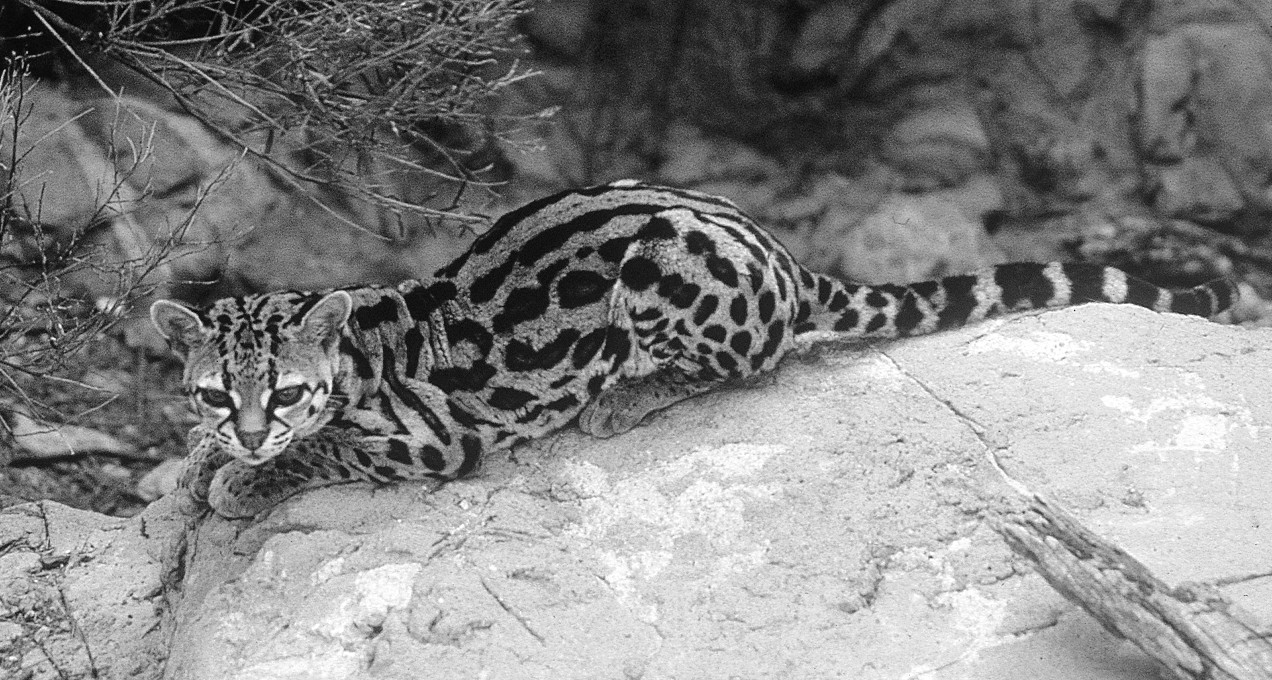MARGAY
Leopardus wiedii (Schinz 1821)
Order Carnivora : Family Felidae
DESCRIPTION. A small, spotted cat similar to the ocelot in color and color pattern but smaller, more slender, and usually with longer tail; skull seldom >110 mm in greatest length. Dental formula: I 3/3, C 1/1, Pm 3/2, M 1/1 × 2 = 30. External measurements: total length, 862 mm; tail, 331 mm; hind foot, 112 mm. Weight, 2–3 kg.

DISTRIBUTION. The margay is a Neotropical felid that ranges from northeastern Mexico to northern Argentina. It is recorded from Texas on the basis of a specimen recorded near Eagle Pass, Maverick County, before 1852. Remains of this species have been found in Pleistocene deposits along the Sabine River in Orange County, so a few thousand years ago it may have ranged over a wider part of Texas. The margay probably reaches the extreme northern limits of its current distribution in northern Mexico, about 240 km (150 mi.) south of the Texas border.

SUBSPECIES. Leopardus w. cooperi.
HABITS. The margay inhabits the forested areas of tropical America. It is not a common animal, and its habits are not well known. It is adept at climbing trees, in which it is likely to be found resting during the day. The margay spends some of its time foraging in trees, catching birds and small mammals, but also captures prey on the ground. Its prey includes monkeys, tamarins, sloths, squirrels, opossums, birds, rats and smaller mammals, various reptiles and amphibians, and domestic chickens. Little is known about the reproductive habits of margays. Females normally give birth to a litter of just one or two kittens after a gestation period of 9–12 weeks.
POPULATION STATUS. Extinct–extralimital. This species is extinct in Texas, having been known on the basis of a single specimen taken near Eagle Pass sometime before 1852. The margay probably was never very common in Texas and perhaps represented only by a few transient individuals from Mexico.
CONSERVATION STATUS. The IUCN lists the margay's status as near threatened and decreasing in numbers. The margay is listed as threatened by TPWD, but probably should be listed as extirpated from the state. The USFWS lists the margay as endangered in Mexico, but the former US subspecies is not listed. The species presently is known from tropical eastern and western Mexico southward to Paraguay and northern Argentina. One of the smallest of American spotted cats, it is regarded as decreasing in numbers throughout its range.
REMARKS. The generic name for this species has been changed from Felis to Leopardus.
From The Mammals of Texas, Seventh Edition by David J. Schmidly and Robert D. Bradley, copyright © 1994, 2004, 2016. Courtesy of the University of Texas Press.
Natural Science Research Laboratory
-
Address
Museum of Texas Tech University, 3301 4th street, Lubbock, TX 79409 -
Phone
806.742.2486 -
Email
nsrl.museum@ttu.edu

